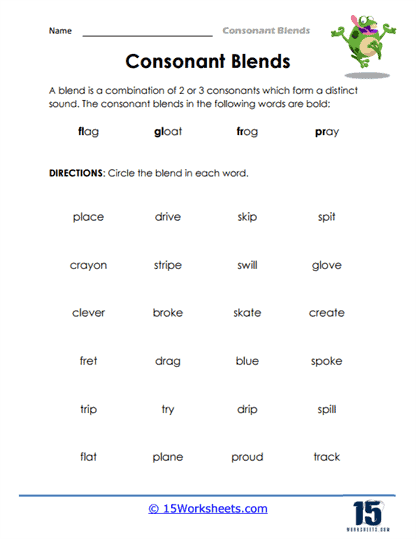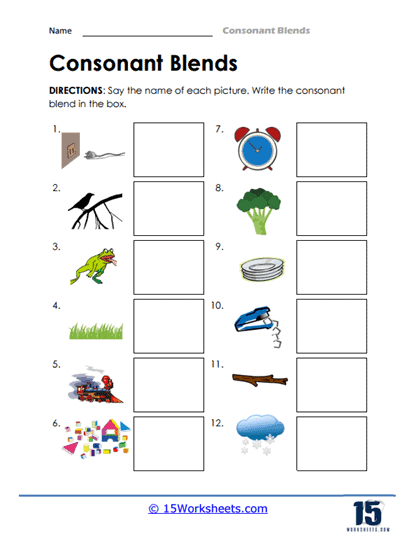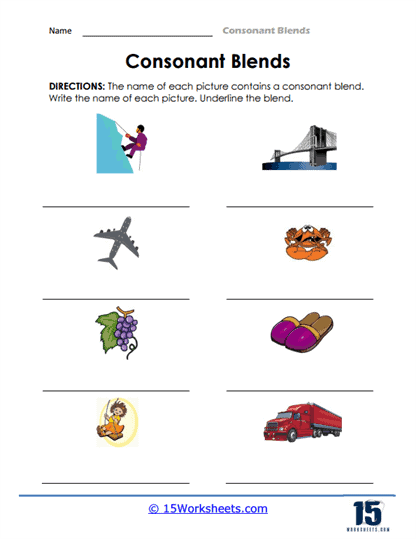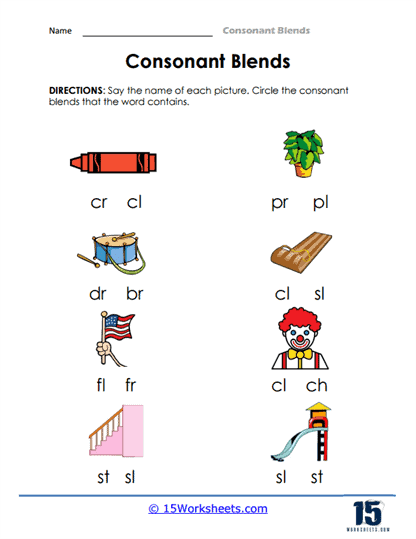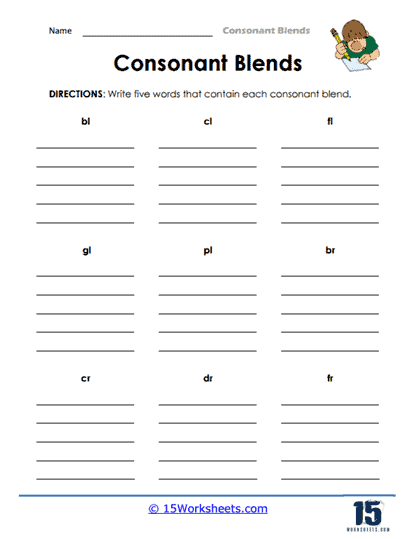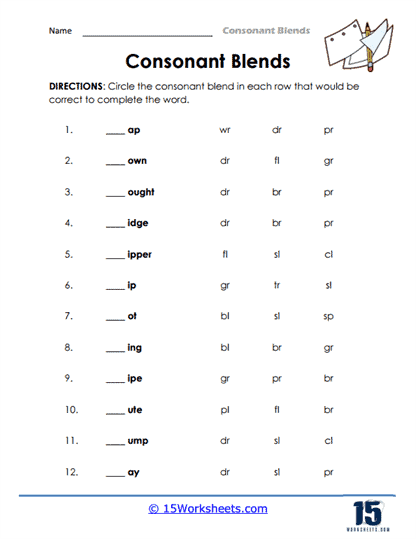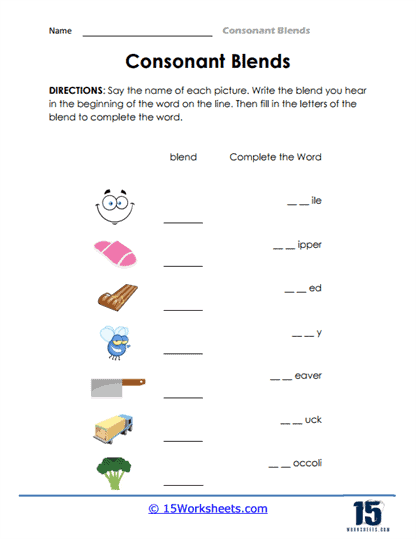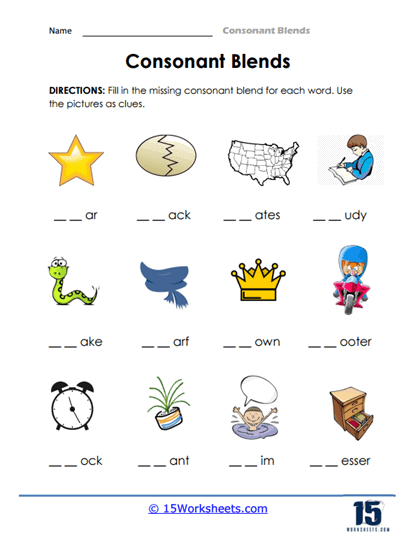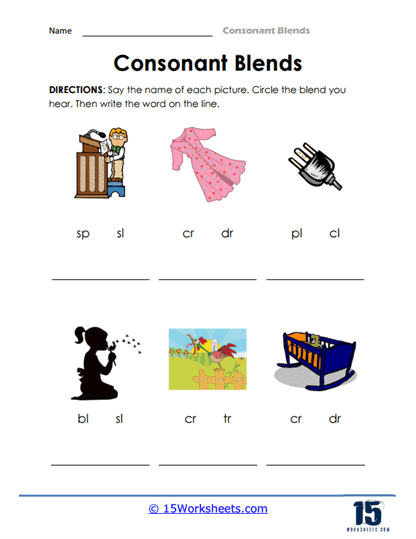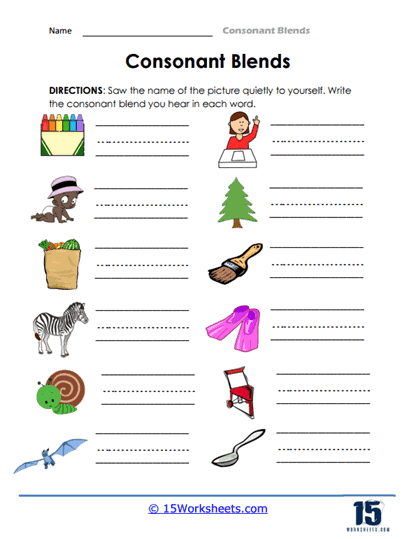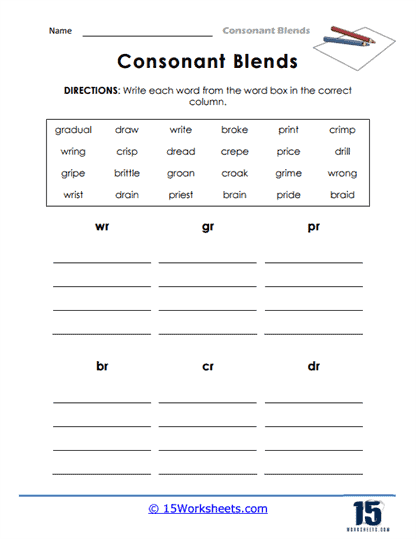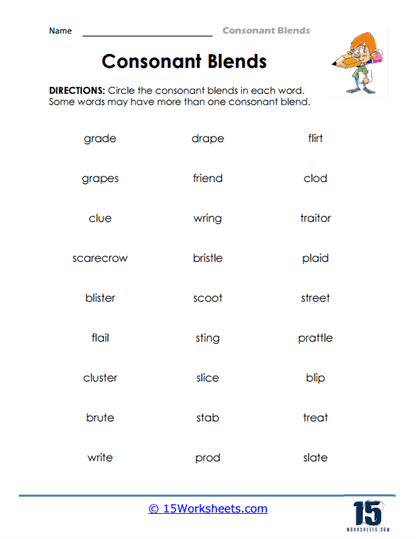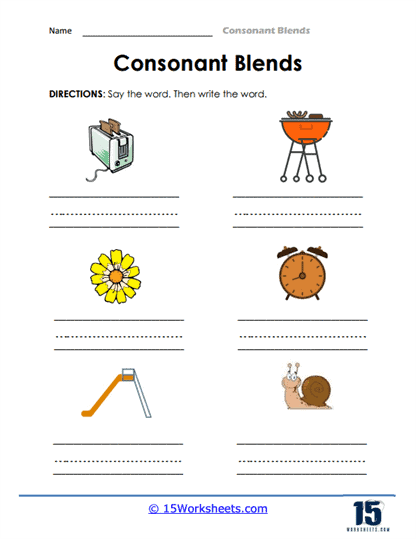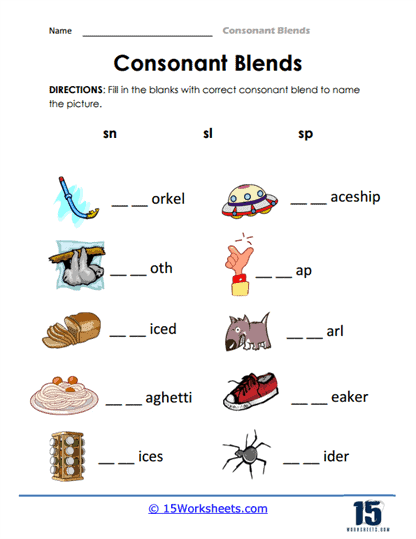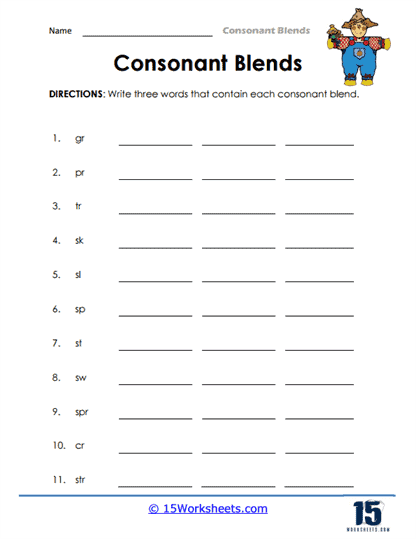Consonant Blends Worksheets
All About These 15 Worksheets
Consonant blends worksheets will help learners improve their understanding of consonant clusters, also known as consonant blends. These worksheets are typically geared toward younger students, early readers, or individuals learning English as a second language (ESL). The primary goal of these worksheets is to teach learners how to recognize, pronounce, and use consonant blends in words. By focusing on the unique challenge of blending consonants together while retaining their individual sounds, these worksheets guide learners toward greater proficiency in reading, writing, and speaking.
The worksheets come in various forms, featuring a wide range of activities that target specific reading and pronunciation skills. They often include visual aids, word lists, and interactive exercises that engage learners in different ways, making the process of mastering consonant blends more approachable and enjoyable. While the concept of consonant blends may seem simple, understanding how different consonant sounds work together without vowels is essential for reading fluency and accurate word pronunciation.
One of the primary benefits of consonant blends worksheets is their ability to help learners break down words into smaller, more manageable parts. By focusing on consonant blends, learners can practice decoding words that might otherwise be overwhelming. For instance, when a young reader encounters a word like plant, they may initially struggle to read it if they view it as a string of unrelated letters. However, by identifying the “pl” blend at the beginning, they can immediately break the word into recognizable chunks, making it easier to read. This skill not only improves reading fluency but also boosts confidence in tackling more complex words.
These worksheets are also vital for building phonemic awareness, which is the ability to hear, identify, and manipulate individual sounds in words. By isolating consonant blends, worksheets allow learners to focus on specific sound patterns, helping them distinguish between blends such as “bl” and “br” or “st” and “sk.” Over time, this strengthens their ability to understand the structure of words and improves their pronunciation, spelling, and overall reading comprehension.
In addition, consonant blends worksheets can enhance spelling skills. As learners become more familiar with common blends like “cl,” “tr,” or “mp,” they gain the tools to spell words correctly without second-guessing themselves. For example, if a student knows that “bl” is a common consonant blend, they are more likely to spell words like blue or block accurately. This increased awareness of word structure can make spelling less intimidating and more predictable for learners.
A Look at the Worksheet Collection
Each worksheet is a new adventure in auditory elegance, starting with Hunting For Blends, where students become blend bounty hunters, tracking elusive letter pairs like “bl” and “cr” through the wild jungles of phonics. With sharpened pencils and keener ears, they go full Indiana Jones-minus the snakes.
Then there’s Say And Identify, where students go from amateur linguists to full-blown sound detectives. They listen, speak, and point dramatically at consonant blends like they just solved a mystery on a British crime show. Next comes Write And Underline, a deceptively calm worksheet that subtly demands the hand-eye coordination of a calligraphy master. Here, students not only write words-they underline the magic blend hiding inside like a secret ingredient. And if that wasn’t enough phonetic drama, Choose From Two raises the stakes with a classic either-or showdown: Is it “plant” or “pant”? Only the boldest blend whisperers prevail.
By the time we reach Word Wizard, students have earned their magical stripes. They conjure up words from blends like “sn,” “gr,” and “fl” with the flourish of a Hogwarts graduate. Fill In The Gaps turns this wizardry into wizard triage, demanding that kids diagnose and repair words missing their crucial blends. Like doctors for incomplete language, they heal wounded syllables with compassion and consonants. Then Complete The Words and Picture Clues double down on visual and phonemic intuition, asking kids to fuse images and incomplete sounds into whole words-think “shovel” missing its “sh” and a picture of a guy digging furiously for answers.
Sound Sleuth continues the phonics crime scene investigation, where nothing gets past a sharp ear. This worksheet dares students to sniff out blends lurking at the beginning or end of words like linguistic bloodhounds. Then it’s off on A Quiet Quest, which sounds like a meditative spa retreat but is actually a blend-finding mission so sneaky it should require night vision goggles. Classify The Assortment and Seek Them Out are like the Marie Kondos of consonant blends: sort, organize, spark joy-only with “tr” and “sk” instead of kitchen utensils.
Finally, we descend into the wonderfully weird with What’s That?, where students look at mysterious objects and name them using their blend knowledge, as though auditioning for a very niche game show. Name The Images gives kids a similar challenge with fewer existential undertones, while Words Bonanza is exactly what it sounds like-a free-for-all buffet of consonant blend chaos where students unleash everything they’ve learned in a glorious phonetic explosion. It’s like a word party and every blend is invited.
What are Consonant Blends?
When we think about the words we speak and write, we often focus on the letters and how they form words. However, there is a significant layer of complexity in the way certain sounds, particularly consonants, come together in language. One key component of this is the concept of consonant blends, sometimes referred to as consonant clusters. These blends play a critical role in how we articulate words, how words are structured, and how fluent we become as readers and speakers. Let’s explore what consonant blends are, why they matter, and how they show up in everyday language.
Consonant blends occur when two or more consonant sounds are placed side by side in a word without any intervening vowels. In simpler terms, consonant blends are groups of consonants that appear together, but each consonant maintains its distinct sound when pronounced. This differentiates blends from digraphs, where two letters work together to make a single sound (like “sh” in “ship” or “ch” in “chair”). In a consonant blend, each letter in the group contributes individually to the pronunciation of the word.
To visualize this, consider the word blend itself. The “bl” at the beginning of the word is a consonant blend. When you say blend, you can distinctly hear both the “b” sound and the “l” sound, even though they are pronounced closely together. Consonant blends can occur both at the beginning of words (initial blends) and at the end of words (final blends).
Common Examples of Consonant Blends
Consonant blends are everywhere in English, making them an integral part of language learning, particularly for young readers or learners of English as a second language. Let’s look at some common examples:
“st” Blend – Seen in words like star, stay, and stop, the “st” blend is frequently encountered in both written and spoken language. The “s” and “t” sounds are pronounced in quick succession but remain distinct. Think about how you say the word stop: first, you make the “s” sound, followed by the sharp “t”. This type of blend helps with the crispness of pronunciation.
“pl” Blend – Words like play, plane, and please feature the “pl” blend. If you carefully say the word play, you can hear the quick transition from the “p” sound to the “l” sound. This blend is often found at the beginning of words and provides a smoother, more fluid sound to everyday language.
“fr” Blend – You might not notice it, but words like free, frog, and fruit all start with a consonant blend. In this case, the “f” and “r” sounds work together in such a way that neither sound dominates, yet both are crucial to the pronunciation of the word. The “fr” blend contributes to the rich variety of sounds in the English language.
“nd” Blend – This is an example of a final consonant blend. Words like sand, hand, and bend end with a combination of “n” and “d”. When you say hand, the “n” sound flows right into the “d”, creating a smooth transition that completes the word. Many final blends, like “nd”, help give words a satisfying finish and are often found in past-tense verbs, such as landed or ended.
“mp” Blend – Another common final consonant blend can be found in words like jump, lamp, and bump. The “m” and “p” sounds combine seamlessly, but each letter retains its unique pronunciation. When you say bump, you can hear the “m” sound right before the “p” closes out the word. This final blend gives these words a punchy, crisp ending that makes them easy to recognize and pronounce.
To reinforce the understanding of consonant blends, many teachers use engaging activities that get students involved with these sound patterns. Worksheets that include matching games, sorting exercises, and word-building tasks are common tools. For example, a worksheet might ask students to match words with similar initial or final blends or to circle blends they find in a list of words.
Another effective strategy is encouraging students to think of other words that share the same blend. If they know that frog starts with “fr”, can they think of other words that do the same? This type of exercise not only solidifies their understanding of blends but also expands their vocabulary.
Why Are Consonant Blends an Important Part of Phonics?
Reading
Consonant blends are combinations of two or three consonant sounds that appear together in a word without any vowel sounds between them. By learning and practicing consonant blends, children enhance their reading abilities. They become more adept at recognizing and decoding words, which leads to improved reading fluency and comprehension.
Word Recognition and Phonemic Awareness
Consonant blends appear frequently in the English language, both at the beginning and end of words. By mastering consonant blends, children develop a broader sight vocabulary as they become familiar with common words containing blends. This enhances their ability to quickly recognize and read words, facilitating smoother and more efficient reading.
These blends also help develop phonemic awareness, which is the understanding and manipulation of individual sounds (phonemes) in spoken words. By focusing on blends, children learn to isolate and blend the individual sounds, which strengthens their overall phonological skills. This phonemic awareness is essential for building a strong foundation in reading and spelling.
Vocabulary Expansion and Spelling
Learning consonant blends expands a child’s vocabulary. Many words with consonant blends are frequently used in everyday language. By recognizing and understanding blends, children can comprehend and use a wider range of words, leading to more expressive and precise communication.
Consonant blends play a significant role in spelling accuracy. When children understand blends, they can apply that knowledge to spell words correctly. By recognizing the patterns and sounds associated with blends, they can choose the appropriate consonants and construct words accurately.
Phonics Generalization
Consonant blends help children generalize phonics rules and patterns. By studying blends, children become familiar with common combinations of consonant sounds. This knowledge can be applied to decode unfamiliar words or spell new words that follow similar patterns, promoting independent reading and writing skills.

